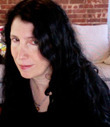Caroline Leavitt's Blog, page 101
December 11, 2012
Want to read a preview of Is It Tomorrow? (May, Algonquin Books)
The Baby is taking a first step! If you'd like to read an excerpt (the novel will be published by Algonquin Books in May 2013), here's the link.
Published on December 11, 2012 13:16
December 8, 2012
And introducing...Is This Tomorrow cover
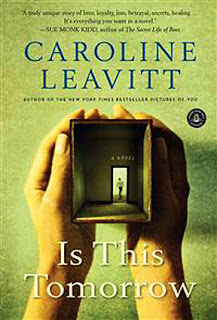
The baby is here! Delivery date is May7, 2013
What does it mean to be an outsider in a community? How do we keep the ones we love safe? in 1950s suburbia, everything is meant to be perfect, even as paranoia about Communism and nuclear bombs winds its way through the supposed paradise. But when divorced, sensual-without-meaning-to-be, Jewish single mother Ava rents a house with her 12-year-old son, Lewis, she struggles to fit in and find her place in the neighborhood. Lewis finds solace with the only other two fatherless kids on the block, his best friends Jimmy and Rose, but when Jimmy vanishes one day, Ava is suddenly suspect and Lewis and Rose's life will be changed forever. A novel about people trying desperately to uncover secrets about the past--and about themselves.
"From the lockstep '50s into the do-your-own-thing '60s, Caroline Leavitt follows her cast of lonely characters as they grapple with the sorrowful mystery of a missing child. 'Are any of our children safe?' one asks, and of course the answer is no, no one is. Like Mona Simpson's Off Keck Road, Is This Tomorrow is an intimate meditation on time, loss and destiny."Stewart O'Nan, author of Emily, Alone and The Odds
“A beautiful free-spirited divorcee is shunned by her neighbors. A boy from that neighborhood goes missing. This is the engine that drives Leavitt’s latest story, a page turner from first to last. I loved the way Leavitt’s Mad Men-like examination of shifting American values dovetails with her vivid tale of heartbreak and hope. An enthusiastic thumbs-up from this grateful reader."Wally Lamb, author of The Hour I First Believed, I Know This Much is True, She's Come Undone
"Leavitt’s first historical novel is a grand slam. Her attention to detail and dialogue are remarkable. The ratcheting tension as an Eisenhower era neighorhood searches for a missing boy-gripping. The resolution of the mystery years later, both heartbreaking and hopeful. I so admire Leavitt’s ability to pull you into the story, tie you up, and leave you guessing, until she masterfully guides you through the twists and turns towards, home. ” Lesley Kagan, author of Good Graces
"Leavitt asks the big, equivocal questions: What does it mean to be a mother, a family? What is the nature of identity? The answers will provoke you, frustrate you, rearrange your heart." Jacquelyn Mitchard, author of The Deep End of the Ocean and What We Saw At Night
"An expertly rendered novel that poignantly chronicles the aftermath of a family’s worst nightmare and its far-reaching devastation. At once haunting and elegant, Is This Tomorrow will leave the reader shattered and hopeful right up to the shocking end.” Heather Gudenkauf, author of The Weight of Silence
"Is This Tomorrow is the gripping tale of a boy gone missing in 1950s suburbs and of of those whose lives are enveloped, tangled and changed by the mystery: the missing boy’s sister, his best friend, and the divorced working mom who can’t fit into the neighborhood. With wit and a perfect eye into the human heart, Leavitt has given us a truly unique story of love, loyalty, loss, betrayal, secrets, healing—and a resolution you’ll never see coming. It’s everything you want in a novel.”
Sue Monk Kidd, author of The Secret Life of Bees
"In her dynamic follow-up to Pictures of You, Leavitt has given us that rare and irresistible combination of tenderly crafted, richly layered and utterly believable characters I found myself caring about by page ten--and a crackling suspense story that just about explodes off the page. Call it a literary thriller: Is This Tomorrow reveals a world you will want to linger in, and secrets you’ll stay up late to untangle. Reading this story is a memorable and moving journey and one that (for those who don’t already love her work) reveals Leavitt to be a brave and humane writer who also understands what keeps us turning the pages.”
Joyce Maynard, author of The Good Daughters and Labor Day
Published on December 08, 2012 19:11
December 3, 2012
Rochelle Jewell Shapiro talks about Kaylee's Ghost, inspiration, being a psychic, and so much more
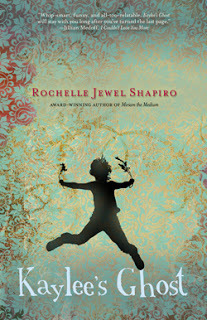
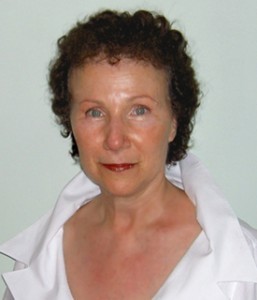
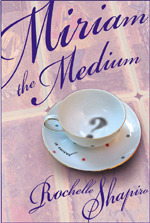
Critically acclaimed novelist Rochelle Jewell Shapiro is an integral part of my life. I can't imagine the planet without her in it, both as friend, trusted reader, and totally mischievous partner-in-crime. But there's even more interesting about her. Her piece for the New York Times Lives, "The Medium Has A Message" reveals her whole other life as a psychic.
Her first novel, Miriam the Medium, published by Simon and Schuster, was nominated for the Harold U. Ribelow award and on the list of summer reading at the Hartford Courant, and was highly successful in The U.S., the United Kingdom, Belgium and Holland. Her second novel, Kaylee's Ghost, a sequel, is just out now in paperback, and soon to be out as an ebook, and it already has a rave blurbs. Jillian Medoff, author of I Couldn't Love You More, calls it "whip-smart, funny and all too relatable." Dana Kennedy MSNBC correspondent and New York Times contributing writer, says it's "charming, warm and hilariously funny, filled with characters so memorable you expect them to come to dinner," and Robin Gorman Newman, associate producer of the play Motherhood Out Loud, says, Kaylee's Ghost is "heart-stopping, poignant and wryly comic."
About how far we'll go to protect our children, the nature of identity, and passed-on-through-the-generation gifts which may or may not turn out to be curses, Kaylee's Ghost is a perfect holiday gift. And even better, Rochelle will happily supply signed, hand-drawn book plates for anyone who would like one. Just message her through her website. Or message me and I'll make sure she gets your address.
Thank you so much, Rochelle, for being here!
What lessons did you learn in the writing of that book that spurred you on with Kaylee's Ghost?
From writing Miriam the Medium , I learned that I didn’t have to know the entire plot beforehand. I could write what came to me and later worry (and I mean worry) over what order to put the scenes in. Where to begin? To end? My mind delivers images that I need to go with, whether they end up edited out of the book or not. There is no such thing as “wasted writing.”
Your New York Times Lives column, The Medium Has A Message was about your life as a phone psychic, and how sometimes, as soon as you say that is what you do, people look at you as if you've dropped IQ points. Do you find that this attitude is changing?
It’s definitely changing. Today, everyone wants to be a psychic. If they find out I’m a psychic, I’m treated to long stories of how psychic they are. And I mean “treated.” It’s exciting to live in an era where a psychic can be proud.
How does being a psychic inform your writing?
When I’m working as a psychic, I receive images and associations, scents and sounds. I feel sensations in my body that turn out to be a hint at what’s wrong with someone else. If I see a wedding ring cut in half, I know the marriage will end or has already ended. If I smell lavender, I know my Russian grandmother, my bubbie, from whom I inherited my gift, is somewhere around me, because she always puffed lavender talc on her creased neck. Sometimes I hear messages, a faraway voice telling me, “She owes me plenty.” When I’m writing, I also use all my senses and when I get that aha moment of insight where I see how things fit together, I know my sixth sense is at work too. All insight comes from ESP, the awakened dreamer, like Newton getting the formula for gravity by being bonked on the head with an apple while sleeping under a tree.
What's your daily writing life like?
Gosh, I have to admit that I mostly write from 10:00 pm to 2:00 am. because all day I’m getting calls from clients or potential clients and or teaching a writing class at UCLA Extension. Late night is the bewitching hour for me.
What's obsessing you now and why?
The people left homeless from the storm, global warming that’s causing “the storm of the century” to occur twice in two years, the soldiers coming back with wounded bodies and psyches, whole countries subjected to tyrants and lawlessness, and my next novel which has been half-finished for way too long.
What question didn't I ask that I should have?
You didn’t ask where my material comes from. Like myself, Miriam Kaminsky, the heroine of both Miriam the Medium and Kaylee’s Ghost is a phone psychic who lives in Great Neck, NY and has a pharmacist husband. But there’s more to it than that. I am driven to write about the immigrant experience and the shifting bonds between family members--how each one fights to hold onto an identity, even one as ill-fitting as the before-you-gained-twenty pounds-sweater. And most of all, I’m driven by the relationship between ourselves and our ghosts.
Published on December 03, 2012 11:14
Meg Pokrass interviews J. P. Smith, the author of 25 novels on writing, discipline, screenwriting and so much more
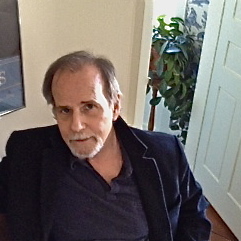
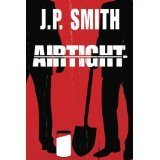
The author of 25 books and a screenwriter--what could make a more fascinating interview? Thank you, Meg Pokrass and J.P. Smith for this lively conversation!
JP, is it true that you have written 25 or so novels? How many have been published? please discuss the discipline of writing here, your own way... I wrote twelve novels before my first, The Man from Marseille, was published in the UK in 1985 and in the US a year later. So I was writing a novel a year, and pretty much stuck to that regime for the years to come. I’ve published six, with my latest just out in November 2012, so that’s not a bad ratio. Many of those novels were written when I was living in England, and as they were left in a box with some old neighbors, they’re now as lost as the neighbors are. Some were, as I remember, pretty good, some not so terrific.
As for the discipline involved, I began writing in 1973, when I took a teaching job at my old school in Westchester County, NY, thinly disguised as the protagonist’s children’s school in Airtight. I taught there for four years, and every day I’d come home and write twenty-five pages. By doing that I learned how to create a flow (which some readers still find a bit confounding) in my fiction, so that I could move fluidly between past and present, between memory and life.
I suppose it was like a musician practicing for hours every day, simply learning the craft, working the scales, seeking just the right tone and touch. During those years before I moved to London it was impossible to get an agent without having been published, and vice-versa, but I kept querying agents and publishers, and eventually an editor at Little, Brown took an interest in my work. Until she disappeared, too.
But it was when I moved to England, that I really began to learn the craft. I worked hard there, producing teleplays and novels, and in the afternoons walking the fossil-strewn beach (or strand, as it’s called). It was a pretty healthy regime. Writing teleplays in England gives you a sense of language can be a balm as well as a weapon. Many English dramas could be hugely successful just featuring two men and a bottle of Scotch in a drawing room. And then the woman enters, and the war begins over her. It gave me a sense of how to use dialogue in a natural and effective way.
As for discipline, I still can’t go a day without writing. Right now I’m working on a screenplay and have been writing a new novel, as well..
Discuss the process of taking your own work from a screenplay to a novel... what an adventure. And anything related to this process.
One of the great things about a screenplay is that it has to possess structure, whether in the traditional three-act form or in a variation of it. When turning that story into a novel—not a “novelization,” which is a whole other thing—you have at the very least an armature on which to apply all the important elements: the subtleties of character, the extended flashbacks, the sheer texture of a long work of fiction to create what the novelist Henry Green called the “long intimacy between strangers,” something that’s really not possible with a screenplay. So the screenplay becomes the skeleton of a much larger, wider and deeper work. And the great thing is that you have that structure to work with.
How do you come to terms with what DOESN'T happen in screenwriting as we all know that is most of the business, the target audience being 14-year-old boys... and so forth? What keeps an artist going in this tough environment?
The sheer craft of it. I love writing screenplays. It’s like beginning with a picture and turning it into a jigsaw puzzle for the audience to piece together. It’s full of rules—the traditional 120-page limit is now closer to 103 pages, especially for thrillers, even less for comedies—and though some young writers try to walk away from them, it’s not hard to see, when watching a movie, that certain things happen at certain times: the inciting incident ten minutes into the movie; the act one turn at around the 25-minute mark; the second act reversals; the third act denouement.
It’s like when I asked my students to write a sonnet. They far preferred that to when I asked to write something in free verse. The sonnet is loaded with rules, and that makes the process somehow more compelling and engaging. It’s the difference between working with a recipe and throwing a handful of disparate ingredients at someone and simply saying, “Cook."
As for the business end of it, just as publishing has become far more difficult to break into these days, especially with the industry in a spiral of uncertainty, what with the popularity of e-books and the advent of companies such as Amazon getting into the business, selling screenplays (or even having them optioned) is very, very difficult. It costs comparatively very little to publish a book; it costs a great deal more, several millions, to make a movie.
So development executives and producers are also very wary of taking on something new. If it failed it could lose their company millions of dollars and potentially cost them their jobs. It’s why one tends to see the same movie over and over again—the same comedies about 40-year-old guys acting as if they were nine, the same thrillers with the same old tropes. Then there are the vampire and zombie pictures, which I was long over when I was ten years old. I mean, what more can one say about these creatures? Though I still do love Jacques Tourneur’s I Walked with a Zombie, even just for the mood and atmosphere of it.
Please talk about the value of mentors in your own life
When I’d just finished my first work of fiction, six months or so after completing grad school, I dropped a note to a former professor and mentor, John Morressy, asking if he’d please read it. When I studied with him he’d already published two novels with Doubleday, campus satires similar to Lucky Jim, had been the youngest fiction writer to get published in Esquire magazine, and was branching out in his career to writing science fiction and fantasy, where he really made his name. He very kindly read my deathless prose and wrote me an important letter. He wrote that the book shouldn’t be shown to publishers, as it was probably unpublishable, but that it showed enough promise that if I worked hard at it for five years he’d bet I’d find a publisher. He was off by seven, but the letter kept me going. He also wrote that now that the only thing he wanted to read by me next would be between hard covers. I was on my own. We remained close friends until his death a few years ago.
But he gave me great advice about the publishing business, and he also said this, which I’ve passed along to younger writers: “One day you’ll fall to your knees and thank God no one ever published your earliest efforts.” How right he was.
A theme in your work is memory and the invincibility of youth.. Can you talk about this recurring theme/themes.
I’m of Russian ancestry, which immediately means that I came from a family laden with secrets, and, because we’re Jewish, tons of angst and guilt. I have only a choppy, unchronological memory of my youth, so memory is a constant theme in my work. When I discovered Proust, reading him first in English, when living in England, and later in French, I found my touchstone. Another author who deals almost exclusively with the phantasms and lost threads of memory is the French writer Patrick Modiano, a particular favorite of mine whose work I’ve been following for well over thirty years.
But I’ve always resisted writing out of my own life. The Man from Marseille, my first novel, once again available from Thomas & Mercer, is about a Russian-born writer living first in the South of France in the ‘30s, in Occupied Paris, and finally, where the novel begins and ends, in London in the late ‘70s. His parents were crooks and thieves (and possibly murderers), and the story he tells alternates between his attempts to make a living as a writer, and tales of his parents and the life he led with them. It’s only when you reach the end that you realize that you have no idea whether the story you’ve just read is his truth, or a smokescreen. He may be the same kind of con man his parents were. In any event, he’s a man in search of plot, a genuine memory, something I can definitely identify with.
My new novel, Airtight, is drawn from my experiences in the ‘60s. Though I’m not the main character (nor any of the others), many of his experiences are mine, and it was great fun dipping into the past for the book.
I’m interested enough in the notion of memory that my next novel is to be built upon a screenplay I wrote (and that’s still sometimes read), THE MEMORY THIEF, a kind of dystopian, slightly futuristic noir set at a time when the federal government owns our memories after death, and when memories have become a commodity to buy, to sell, to erase, and to protect. Yeah, it’s science fiction in a way (and I read virtually no SF), but I’m enjoying this immensely.
Talk here a bit about the writing of "Airtight" - How this book was born.
Airtight began when my wife and I were watching Quentin Tarantino’s Jackie Brown. I’d seen it before, but this time it rang a bell. I turned to my wife and said, “We never dug it up.” Back in the ‘60s, when I was attending a college so tremendously unsuited to my background and sensibility (having to wear a freshman beanie is nothing like having to wear a yarmulke, believe me) that I reveled in illicit substances as a horse rolls around in dirt on a hot day: with immense enjoyment as I indulged in grass, hash, opium, lots of acid, and an addiction to speed. Nick’s acid trip, comprising the first chapter of Airtight is exactly the one I experienced. It was also the day I gave up drugs. I’d been to the edge and perhaps a bit over, I’d seen everything one could possibly see on drugs, and there was no more need for it. I was clean.
Back to the plot of Airtight, few guys and I did a deal in Cincinnati for around $450 worth of grass and hash. It turned out to be crap. As I write in the book, when the usual euphemisms for grass were “tea,” “boo” and “reefer,” the other old standby, “shit” (as in “let’s go smoke some shit) this time almost literally applied. It was like travelling a few hundred miles to buy food and being handed a bag full of manure. Sure, you could eat it, but why would you want to?
It was tough to sell on this Midwestern Baptist campus, and so someone had the bright idea to bury it in Mason jars near one of the playing fields. In the novel, I switched it to heroin.
I had more fun writing this book than any other. It’s a darkly comic crime story, but also a deeply moral one. As the main character, ex-ad-man Nick Copeland, returns to his past not only to retrieve the drugs but also to run into some painful memories, he realizes there things he had done in his life which should not have been done, and there were things he should have done. By a simple gesture or word, by being in the irresistible breeze of youth, he had initiated things that turned out tragic for others. And so, at the end of Airtight he makes a decision which has already confounded some readers, but which, to me, seems exactly right. For those looking for a shootout in the mean streets of Scarsdale, it’s not going to happen. This is a novel that has to ring true, not become someone else’s movie.
What do you do to get unblocked creatively? Do you get writer's block? any tricks or tips to making things flow?
Touch wood, I don’t get writers’ block. I always try to keep a few projects percolating at once. There have been times when I simply couldn’t come up with an idea. I found that wandering through a bookshop, leafing through books I hadn’t read, could get things going. First lines, in particular, always helped.
My mentor used to say at such times that I should read Yeats’s “The Circus Animals’ Desertion,” which is about this very thing, the loss of inspiration. The circus has left the town in your head, you think you’ll never have another idea worth writing about, and he counsels that we should go perhaps to where we’ve never gone before: “Now that my ladder's gone,/ I must lie down where all the ladders start/ In the foul rag and bone shop of the heart.” Take those old experiences, brutish and humiliating as they may have been, and raise them to the level of art.
It was how Airtight began, in fact. The foul rag and bone shop. Open all hours.
Please tell us your favorite films which have been adapted from novels…
Ah, interesting question. Ever since I first read and taught him, Pinter has been an influence, and I’ve always loved many of his screenplays, nearly all of them adaptations of others’ works. He was an astute and sensitive reader who could locate the cinematic essence of a work in a brilliant and often unexpected way. His approach to, say, L.P. Hartley’s The Go-Between, Fowles’s The French Lieutenant’s Woman (an especially tricky novel to translate visually, with an ingenious solution provided by Pinter), and his unproduced, but eminently readable, Proust Screenplay, based on the entire seven volumes of A la Recherche du temps perdu, is astonishingly successful. In every case he’s faithful to both the poetry and the heart of the each book, and with his actor’s sensitivity to how a scene can be played to maximum effect, he has achieved something in these screenplays and others which is hard to equal.
As for others, I have a particular favorite in The Vanishing, the original Dutch-French version based on the Tim Krabbé novel, one of the most unsettling and disturbing films ever made, and one I watch at least once a year. I read very little contemporary fiction, unless it’s by an author I follow, and I’m afraid many of them are French. Modiano. René Belletto. Jean Echenoz. Jean-Patrick Toussaint. I’ve been disappointed in so much of contemporary writing. I was asked to review Tom McCarthy’s C, and was amazed at how in artful it all was, how poorly written. This by an author whose Remainder was published to great acclaim. I’m afraid I think Jonathan Franzen vastly overrated. I enjoyed parts of The Corrections, but found Freedom to be a great deal less successful. A good editor would have tapped him on his earmuff and lifted his blindfold (who the hell writes like this anyway? And on a bare floor in Brooklyn?) to say that the ex-cheerleader whose memoir takes up a good chunk of the book shouldn’t really be writing like clever young Jonathan Franzen. She had the same voice as the narrator’s.
To get back to film adaptations, I think it’s a matter of being faithful not so much to the story as to the heart of the original. I mean, were I to adapt The Blue Hour, I would update and move the action to Los Angeles (the city where people go to become someone else), and write it from the point of view of the detective, not the forlorn husband whose wife has gone missing. I’d basically turn the whole thing inside-out and start afresh. Just as Pinter did with The French Lieutenant’s Woman.
Published on December 03, 2012 10:08
December 2, 2012
Matthew Quick, the author of The Silver Linings Playbook talks about writing as therapy, channeling Rocky, not writing the script, his new novel, and so much more
The Silver Linings Playbook by Matthew Quick was one of my favorite novels, so I was a little anxious when I heard it was going to be a film. Films never match up to the books, usually. Endings are changed. The picture of a character you have in your head is always better than the one of the screen. But ah--I was wrong. The film is sharp, funny, deeply moving and filled with great performances. In fact, I was so entranced, I decided I had to track down Matthew, who was kind enough to talk to me about all things Matthew Quick. So this means if you haven't already, track down all his work, do so immediately, and be on the lookout this coming August for Forgive Me, Leonard Peacock, his new novel. Thank you so, so much, Matthew!
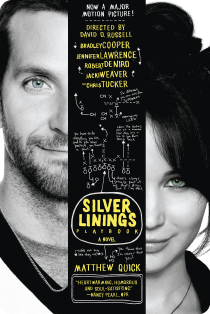
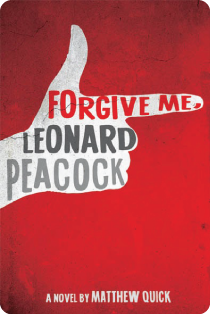
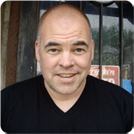
I love your whole take on life--to risk, to never give up, to move towards your dream. You practice what you preached, too, quitting your teaching job to write full-time in your in-laws basement, which gave birth to The Silver Linings Playbook. So what's your next big dream you're moving towards?
I’ve been channeling Rocky a lot lately, particularly the line about how ‘it ain’t about how hard you hit, it’s about how hard you can get hit and keep moving forward.’ (I might have paraphrased that a little.)
When I first started writing full time, I had no idea what I was doing, let alone what ups and downs were coming my way. (This is probably a good thing, as naivety can be a powerful—albeit it, temporary—shield.) At first, I really just wanted to see if I could publish a book with a major house in NYC, which seemed like a Herculean task. Now I’m trying to sustain a career as a full-time fiction writer, which is infinitely harder.
I read once that the best way to achieve a goal is to be like a stone falling through water, always moving in one direction steadily. And that’s what I’m trying to do now. I go back to the page time and time again. I do my best to promote my work. I try to treat people well and be thankful for all that has come my way. I write and write and write.
When the hits come—and no writer is ever really safe—I keep moving forward. So maybe it’s my dream to stay in the fiction game as long as I can.
I write about people who live on the fringe—lonely but interesting and special people. And I think my fans identify with these characters. I hope my work makes people feel less alone. That’s why I write—to feel less alone. My writing is also therapy.
If you’ve read my work, you know that mental health issues are very important to me. I talk a lot about mental health when I speak, and I’ve come to believe that this is maybe the most important part of what I do, aside from trying to tell good stories. I’d like to do more to foster mental health dialogue, to let people in that community know they are not alone. I’ve always used writing and literature to combat my own personal demons. And many readers tell me that the stories I write and the talks I give help. So I keep moving forward.
The Silver Linings Playbook is that rare bird that is not only an extraordinary book but a fabulous movie as well. Were you anxious about how they were going to transform the book?
Thank you! So glad you enjoyed both.
I asked if I could write the screenplay and was told they were looking for an established name. It was a moment when I learned David O. Russell was going to adapt my novel. I’m a huge fan of DOR.
I read an early version of the screenplay, but wasn't involved in the adaptation process. When I visited the movie set, David was friendly, but made it clear that the film was his and the book was mine. I got it. I wouldn’t want anyone looking over my shoulder when I write fiction, and David had to do his thing as a filmmaker.
Before they screened SILVER LININGS for me in Tribeca, David called me on the phone. It was the first time we had a conversation. I was surprised to learn that he really really wanted me to like the film. In fact, I’d even say he was nervous about my reaction.
When I watched the film, my hands were clenched into fists, my chest was tight, and I felt like I was experiencing David’s adaptation as several different people—the writer of the very personal source material, a fan of David O. Russell, a fan of movies, a storyteller, someone who had a financial stake in the success of the film, etc. About twenty or so minutes in, I forgot about all of that and gave myself over completely to the story. That’s when I knew we really had something.
I called David that night and we had a very happy conversation. He and I have gotten to know each other a little while promoting the film. He cares deeply about mental health awareness, like I do. And I really appreciate how respectful he was of my original vision. The movie is David’s, but the heart and spirit of what I was trying to do is clearly up there on the screen. My friends, family, and former students agree.
I was going to ask what it's like to be married to another novelist, but what I really want to ask is what's your daily writing life like? Do you plan out your novels or just follow the characters' leads?
Here’s what my normal day looks like: get up somewhere between 7-9 am; make coffee in the French press; do at least an hour of e-mail (lately, much much more); write for four or five hours; hike the local mountain or walk in the woods with my wife, Alicia, who writes in her office all day and/or crafts solo piano music; write some more; eat dinner with Alicia; on an absolutely crazy wild night we will go to the movies; I usually do Internet career stuff or write some more at night; watch Jon Stewart and Colbert; sleep; repeat.
I never plan out my novels. I start with a character and try to channel him or her in first person. You’ve heard people say, ‘No tears in the writer; no tears in the reader.’ I say the same thing about surprises. I need to have that perception shift during the writing process. I remember reading somewhere this advice from Kurt Vonnegut: make your character want something desperately, and then make the goal really hard to obtain. That’s good advice.
What's obsessing you now and why?
SILVER LININGS PLAYBOOK is getting A LOT of buzz. I’m being read by a larger audience. Stakes are high. Trying to enjoy the ride, but I also have my fingers crossed for many things that shall not be named at this point.
This is a hard game and I realize I’ve had a lot of good fortune already. Just hoping to keep the dream alive.
What question didn't I ask that I should have?
Well, I’m happy to tell you about my next book, which Little, Brown will publish in August 2013. It’s called FORGIVE ME, LEONARD PEACOCK and is about a boy who takes a gun to school on his eighteenth birthday intent on killing his former best friend and then himself. We’re very excited about this book. Early buzz is good. The cover is amazing! And I’m hoping it starts an important dialogue.
I also have another adult market book about which my agents say I’m forbidden to speak. (More on that early next year.)
Thanks so much for interviewing me! My best to all of your readers!
For more info, please visit www.matthewquickwriter.com
 [image error]
[image error]
Published on December 02, 2012 11:52
November 27, 2012
The hilarious Johnny Pigeau of Backbeat Books & Music talks about rewriting the Bible (and a novel, The Nothing Waltz), math problems, selling books and so much more
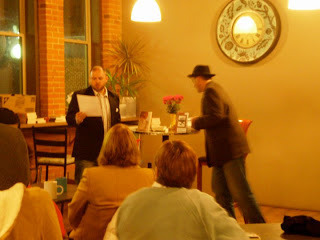
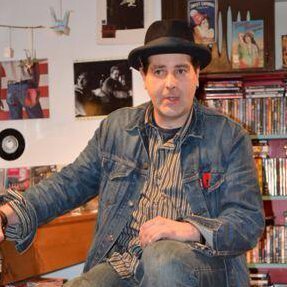
If someone is hilarious and irreverent, they usually go to the top of my list--and that would describe Johnny Pigeau, owner of Backbeat Books & Music, in Perth Ontario, (6 Wilson Street W, Perth Ontario, K7H 2M5) a fabulous store that sells books, vinyl, CDs, DVDs and off-the-wall gifts. I so liked the way he formatted the interview that I left it alone. And I deeply appreciated his attempt at my math problem. Thanks, Johnny!
YOU: You not only sell new and used books, but you also sell vintage vinyl (my husband has our entire basement filled with vinyl), DVDs, and funky gifts. I love this because I bet it means that people come in for a book and they might leave with a lamp shaped like a rocket ship, too. Any further plans for the store?ME: It’s quite true. People often come in looking for Alice Munro’s newest book, say, and leave with a stack Wham! records and a table lighter from the ‘70s that looks suspiciously like a grenade. Another customer was thrilled to walk out with a tiny Hohner children’s accordion and a Brunswick bowling pin. I believe his girlfriend bought a book.And nearly everyone wants to buy my U2 “Desire” poster, but, um, no, that’s not for sale.I’m addicted to thrift shops, flea markets and auction sales, so the shop is always filled with funky gifts. We mostly sell books and music and movies but sometimes that can get boring. You gotta amp it up sometimes. If you leave our shop without at least checking out our vintage Parakeet Training record (“Your parakeet can teach itself to talk!”), well, I’ll consider that a serious personal failure.YOU: You are an author, too, with a book coming out this January, THE NOTHING WALTZ. So that means I have a million questions for you. First, tell us about the book--which sounds great. How do you manage to write while running a store? What was it like writing the book and what's your daily writing life like? As far as process, do you plan things out or do you write and hope for the best? Are you already writing another book?ME: Indeed, I am an author. In grade six, I rewrote the Bible. Well, part of it. I made up a bunch of new commandments. True story. Got a check mark. (It wasn’t a formal assignment.)More recently, in 2009 (ignore what Amazon tells you), I wrote a novel called The Nothing Waltz, which garnered some wonderful reviews and is in its third or fourth printing. I always have a difficult time explaining what it’s about, so here’s the helpful back flap synopsis: “The Nothing Waltz is the story of a misfit. Pigeau, follows the anxiety-riddled misadventures of the prematurely wealthy Finny McKee as he struggles to reconcile a perpetual adolescence-filled with fear, booze, and a string of bewildered ex-girlfriends-with his yearning for an adult relationship. Despite the dubious help of his friends, a troubled collection of fellow eccentrics, Finny finally stumbles into that elusive relationship when he meets Kathleen, a free-spirited single mother. His newfound happiness, however, is threatened when an unexpected crisis forces him to make a difficult decision ... and confront a lifetime of fear.”I wrote the book before we opened the store, actually, and thankfully I had been awarded an Ontario Arts Council grant which gave me the time to write the book. Writing the book was a fun, exhilarating, nerve-racking, hair-pulling experience. Many moments of great creativity and breakthroughs and the joy that comes with molding a character that feels very real and complex and multidimensional, but there were also moments of pale white terror and feverish doubt and long brainstorming sessions/therapy at the pub when it felt the whole thing would never come together. But thankfully it did and lots of people seem to like it. I credit fairy dust, beer nights and my lovely wife, Erin, for keeping me sane throughout the process.I did plan the book. That is, I knew the basic story, but then it took turns of its own as the characters became more and more real to me, fleshing themselves out and leading the way, as it were. Writing a novel truly is an organic experience, I found. You get stuck, you curse, you nap, you throw out lots of paper balls. You wake up at 3 a.m. and everything is clear and the next thing you know the sun is rising and you’ve written 40 pages that, when you read them a bit later, are truly (and bizarrely) a pleasure to read. And I don’t mean that in a braggy way. It just happens: you surprise yourself. It’s like a mechanic at day’s end thinking: “Holy crap, I just took that car apart and reassembled it and now it’s purring like a kitten.” I often wish I was paid as much as mechanic.I’m currently working on my second novel; it’s called Speck (the main character’s name is Templeton Speck) and is due out in the Fall of 2013. Basically, it’s about a shopkeeper who one day realizes he’s living a second-rate sort of life. He’s nearing forty and he’s totally bummed out and baffled as to how to remedy his situation. Templeton’s single, childless, mortageless, perpetually broke, and essentially takes care of his messed up family: a once famous and now drunken father, a sweet, agoraphobic older sister, a rebellious hipster nephew, and a homeless step-mother. Really, it’s more cheerful than it sounds. To me, there is humour in most everything. And if you don’t find it, you’ll go batty. Templeton Speck agrees.It’s also one man’s spiritual journey; it’s not all all about owning a crappy car or living in a cramped apartment with leaky pipes or eking out a living. Finding your place on the planet is every bit as important, if not much more important, than how much money you earn. As is finding love, that one Big Love. And that’s something else Templeton comes to realize over the course of the novel.YOU: Can you talk a bit about events and your store? What has worked well (and were there any funny disasters?)ME: Sure. For two years now, we’ve had a very successful reading series at the shop. It’s called the First Edition Reading Series and we’ve been privileged and honoured to play host to some incredibly talented authors, including some national bestselling authors—Steven Heighton, Tish Cohen, Catherine McKenzie, Terry Fallis, Alison Pick and Tanis Rideout (to name only a few)—and some of Canada’s finest poets, including Phil Hall, who won the 2011 Governor General’s Award (Canada’s version of a Pulitzer) for poetry. Margaret Atwood has agreed to read in Perth in 2013, so we’re looking at organizing a literary festival in Perth—unless she wants to read in our shop, with its 20-seat capacity. That would be super neato cool!No disasters to speak of except the night we brought in a local country musician and one person showed up. I felt so bad I took the guy (the musician) to the tavern on the corner for drinks. Haven’t seen him since. Hope he’s okay.YOU: What three books and three albums are you pressing into everyone's hands these days and why?ME: We’ve been selling Beatles’ albums like crazy since they’ve been remastered and reissued on 180 gram vinyl. Jack White’s album Blunderbuss has been the biggest seller all year, and we’ve also sold quite a few Tom Waits’ records lately. People love them some Tom Waits. Great singer-songwriters—Leonard Cohen, Joni Mitchell, Dylan, Springsteen—seem to sell best around Perth because there are so many musicians here, I think, and people who just love quality music.As for books, lots of people are picking up Tanis Rideout’s Above All Things, a gorgeous, lyrical first novel that weaves George Mallory’s ill-fated 1924 quest to be the first man to conquer Mount Everest with that of a single day in the life of his wife, Ruth, as she waits at home in England for news of his return. The book will be released in the States in February, I believe; trust me, you’ll be hearing lots about it quite soon!What else?Katherine Monk’s Joni: The Creative Odyssey of Joni Mitchell, an illuminating, in-depth portrait of Mitchell’s life so far, has also been selling well. She’s a fascinating artist and it’s a well-written book.A third book doesn’t immediately come to mind but zombies do—anything about zombies is a popular choice right now. Perhaps not coincidentally, Margaret Atwood’s next book is about zombies. Now that will be interesting!YOU: What's obsessing you now and why?ME: Recently, all this Black Friday and Cyber Monday nonsense. Be smart, shop local. Would you rather have a funky indie book and music shop in your town or a boarded up storefront? Indie book and music sellers have to adapt their models to a changing market or they’re history. That’s clear to me and that’s why we are bringing in more and more vinyl (it’s making a huge comeback!), and soon, turntables and musical instruments. Thankfully there are many great folks in our town, as in many others, who will always shop locally realizing it creates local jobs and injects money into the community’s economy. We love those people. When customers become more like friends, you know you’re doing something right, and that’s a remarkably wonderful feeling. Also, they will bring you yummy cookies. So, hey, free cookies! (Suck it, WalMart!)
YOU: And finally, if a train going 60 miles an hour is heading west and another train going 3.5 miles an hour is heading southwest, at what angle will the two trains meet?ME: Don’t trains go a lost faster than 60 miles an hour? They certainly boogie around here. I like riding the train. See lots of pretty girls on the train. Also, peeing while standing and not soiling yourself in one of those tiny washrooms in a speeding train is quite a feat! Proud to say I’ve accomplished that numerous times. At all sorts of angles.
Published on November 27, 2012 14:50
Carol Spurling of BookPeople of Moscow talks about favorite books, community and putting the right book in the right person's hands
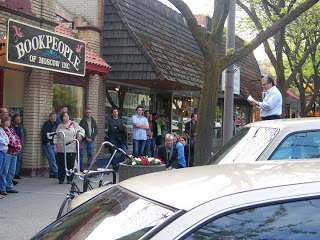
Carol Spurling at BookPeople of Moscow is just fantastic. I loved talking with her because she's so genuinely interested in books and people and her stories are just wonderful. Thank you, thank you, Carol! And watch out for their new website launching this week: www.bookpeopleofmoscow.com.
BookPeople is in transition and under new management. Tell us about that, please.
BookPeople was started in 1973 and has been downtown ever since. Last year the longtime owner (the second) decided to retire and there was about a year of doubt about the future of the store. But there were a lot of us that didn't want to live in a town without an indie bookstore, and a few very special people who did a lot of groundwork helped pair me (and my husband Walt) with another couple (Steffen and Nicole Werner) as business partners and together we have been able to keep BookPeople going and make it even better than it was before. We, the third set of owners, took over on January 1 and remodeled, restocked, and restaffed the store, and reopened on February 22, 2012. The community has been 100% behind us from the beginning. This is an exciting time to be in the indie book business. Things are going our way. BTW our new website will launch later this week, at www.bookpeopleofmoscow.com.What’s the community of Moscow, Idaho like and why is it the perfect place for a bookstore? (Not that anywhere is not a perfect place for a bookstore!)First of all, the people are wonderful; really engaged and aware. We couldn't ask for better customers. As for the town itself: a middle-sized family-friendly community with a university in town, and another university only 8 miles away, gives us all the best qualities of a small town (tight-knit community, safety, no traffic problems, walkable, access to outdoor recreation, good schools) combined with all the advantages the university brings (arts and culture, young people, vibrant downtown food and drink scene, educated population, activists, artists, and organizers, farmers market, food co-op, etc.). I love the mix of rural and farm folk who have been here all their lives, faculty and staff of all ages and backgrounds, and the constant new arrivals who bring new ideas and energy. Our downtown and overall quality of life just keeps getting better and better. And, having previously worked in a bookstore where the busy season was during the summer tourist rush (Old Harbor Books in Sitka, Alaska), I am really grateful to be in a community where the dead of summer is the slowest season and things pick up again in September. It just seems more natural that way. I love the rhythm of a busy school year fall, winter, and spring, contrasted with a lazy summer.I love your Top Seven List on your webpage. How did that come to be and can you talk a bit about it, please?I wrote that pretty quickly on a Sunday night recently as I was thinking about the upcoming holiday season and all the things I wanted our customers to know - and all the things I wanted to make sure I had a handle on. Preparing publicity serves the double purpose of focusing my attention and helping me stay organized. People are pretty annoyed by constant emails from MailChimp in their inboxes, and I don't have time to produce fancy marketing stuff for every little thing, so I decided to take care of a lot of news all at once and just send them this one series of paragraphs, without any photos or color at all. I'm trying to figure out what gets people to open marketing emails and thought a title more catchy than "Latest News" would help.I always ask about author events! What makes a great one, and are there any mishaps that authors should know about?We have been lucky to work so closely with the University of Idaho MFA program and English Department who bring in visiting writers (and provide a large audience of up and coming writers who hang on their idols' every word), and some of our local writers have had book launches this year and were happy to let us host their launch parties. Beer and wine and good snacks help make a great event, along with a reliable sound system and. We're becoming famous for our Fender amp; I hope that when we get a real set of speakers that folks won't be too disappointed not to be using the Fender.Writers who are also funny result in great events. Jess Walter and Steve Almond had 'em rolling in the aisles, of course. But you'd be surprised at who has stand-up comic potential - especially if they write books that are not at all funny. Kim Barnes, for instance, is a hoot. So is Anthony Doerr. And Willis Barnstone, who is elderly now, and probably the most intelligent, learned man I ever met! Alternatively, a writer might not be funny, but if they can read compellingly, the audience will be eating out of their hands. So far we haven't had any big mishaps but I've had a couple of close calls with getting the books on time. That's a bookseller issue and not an author issue. All I ask is that they show up on time, remember their glasses and their marked up reading manuscript, and wait to go to the bar until afterwards. So far, so good.
What three books are you pressing into everyone's hands these days--and why? Only three??? Well, I'm going to be biased towards our local and regional authors who write world-class literature: Kingdom of Men by Kim Barnes, Beautiful Ruins by Jess Walter, and The Revised Fundamentals of Caregiving by Jonathan Evison. Also Blasphemy by Sherman Alexie. Why? First of all, I've gotten to know these writers just a bit and having the tiniest bit of insight and connection to the author makes selling the book a lot easier. The books sell themselves on their own merits - skillful storytelling, addictive plots, memorable characters, relevant themes, plus a little something magical you can't identify - but for me to be able to add something personal makes all the difference. I really can't stop with three or four: Anything Worth Doing by Jo Deurbrouck is a true Western river-rafting adventure story that people in our neck of the woods are talking about. It is also so exciting to have a new Timothy Egan book out too, Short Nights of the Shadow Catcher, which is about the photographer Edward Curtis. I've lived out West for more than half of my life, but as someone who grew up in the Midwest, I am still learning about what makes this part of the country and its people so intriguing, and sometimes, so inscrutable. Writers who share my love for the West always help me understand my adopted part of the world a little better.I think one of the most wonderful things about indie stores is that the sense of community. You get to know your customers and can often anticipate what someone might want to read. Plus, your store becomes a destination. When people ask for recommendations, do you give them what they want all the time, or do you ever stretch the boundaries and suggest something that might broaden their reading horizons?I find that when people ask seriously for recommendations, they don't know what they want at all, aside from certain qualities, for example, fiction or non-fiction or "not too much violence," so, within those parameters, I always just recommend books that I love or that my staff has loved or that is a classic or solid backlist seller they haven't yet experienced. And they're usually thrilled with what we suggest. You can tell if they don't really want a recommendation because they will keep finding reasons to reject your suggestions. I don't know if what I love will stretch other people's reading horizons - I've had staff with much more adventurous tastes than mine - but I just want them to experience something great. I had a customer recently that I directed to Kurt Vonnegut. So he read his first Kurt Vonnegut and came back in right away looking for more. Kids that haven't yet heard of Arthur Ransome's Swallows and Amazons...I get such a kick out of introducing them to an entirely new world. I just got to turn a cozy mystery reader on to Jacqueline Winspear and Laurie King. One of my staff who loves to cook hadn't yet read any M.F.K. Fisher. Anything new to you, that grabs you, is broadening your horizons...that's what I love about this profession. Enlightenment and inspiration happen in our store every single day.What’s obsessing you now and why?Aside from the first-year learning curve of owning a bookstore and all that comes with that I tend to be pretty balanced. I've been obsessed for 20 years with France and French food and culture and that does tend to show up in a few areas of the store like cookbooks and travel and mysteries, and the French conversation group that meets in the store once a week. But I'm starting to feel a niggling interest in Scandinavian and Icelandic culture too, so perhaps my France obsession is fading? I'm obsessed with keeping the store clean and organized. I'm obsessed in the very best way with my new favorite mystery series, Maisie Dobbs, and my old favorites, Inspector Guido Brunetti and Bruno, Chief of Police. And, I've been waiting for the new Downtown Abbey series and the new set of Sherlock Holmes (with Benedict Cumberbatch) from the BBC for what seems like forever. And I've been dreaming about building a house off the grid lately, but I need to keep from obsessing about that too much, until the five years of work we still have to do on our existing house is done.
We will gladly mail books to customers anywhere in the world and we would love to be a destination book store so please consider a visit and we love it when people from big cities come into the store and tell us that BookPeople is the best book store they have every been in.
Published on November 27, 2012 14:40
Chris Livingston of The Book Shelf talks about changing things up, his three fave books, and his obsession with The Hobbit
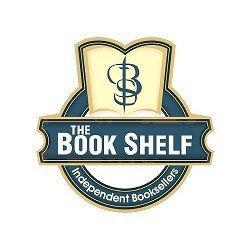

Chris Livingston owns the amazing The Book Shelf (162 West 2nd Street, Winona, MN. (507) 474-1880). The store does all kinds of wonderful things, including a Dinner With The Author evening planned with Julia Pandi for Memoir of Sunday Brunch--which seems like a wonderful, delicious way to interact with an author. I'm thrilled and honored to have Chris here. Thank you, Chris!
How do you see the bookstore changing in the next few years?My staff and I regularly try to change things up with respect to author events. We even, on occasion, host an "author-less" event. If we can come up with interesting ways to present books and authors to our customers, we will pursue it. We host the more traditional "reading and autographing," but we take advantage of the great restaurant we share space with to host meal events with authors as often as possible (although, in some cases, patrons are coming for the food as much as for the author). We have found that events work best here in our community if we can partner with other organizations. Example, if we are considering hosting an event for a health-related book, we might partner with the local clinic, physician, acupuncturist, YMCA, etc. We list them as the sponsor, and only ask that they help us promote the event. These partnerships have become critical to not only successful events, but in continuing to allow us to "infiltrate" the community as a whole.What’s your community like and why is it the perfect place for a bookstore? (Not that anywhere is not a perfect place for a bookstore!)Winona is an interesting city. Two universities and a large technical college are located here, along with several thriving manufacturing industries. It is located in the southeast corner of Minnesota, along the banks of the Mississippi River in the beautiful bluff country. Winona is also an arts-tourism based city, playing host to The Great River Shakespeare Festival, Minnesota Beethoven Festival, Midwest Music Fest, and the Frozen River Film Festival. The combination of intellectual and arts/culture interests in the community play right into a bookstore's target demographic.Our store continues to evolve. We continue to diversify our revenue streams in order to ensure steady cash flow. We have published our own book, now in its third printing. We continue to reach out to corporate accounts. We travel throughout the state with travelling book fairs for conferences. All of this is necessary just to keep the lights on and books on the shelves. We have added Kobo e-readers to our lineup and now offer over 3 million e-books through our website. Physically, we plan to expand our children's section (for the third time), as it continues to be the best performing area of our store. We have already added new toy and game lines, as well as a 30% increase in stocked book titles. It seems we are always looking to modify and improve on what we are doing, even if some changes don't always bear fruit.What three books are you insisting everyone read these days?Only three? From what seems like a never ending list of great books this season, I will give you one novel, one picture book, and a piece of nonfiction.
Fiction: "The Revised Fundamentals of Caregiving," by Jonathan Evison, because not only is it a great, well written novel, but because we all need to root for a loser on occasion. My picture book for the season is "Nightsong," by Ari Berk and illustrated by Loren Long. It is such an endearing story of a young bat who is a bit scared of taking his first flight by himself out of the cave, and is encouraged by his mother to use his "good sense," both literally and figuratively. The book's illustrator, Loren Long, is my current favorite. Just a beautiful story with phenomenal illustrations. From the nonfiction side of things, don't miss Susannah Cahalan's "Brain on Fire." Cahalan explores her dramatic descent into madness and live-saving diagnosis that almost came too late. Her narrative is fast paced and sharp, and will grab you right out of the gate. Riveting.I think one of the most wonderful things about indie stores is that the sense of community. You get to know your customers and can often anticipate what someone might want to read. Plus, your store becomes a destination. When people ask for recommendations, do you give them what they want all the time, or do you ever stretch the boundaries and suggest something that might broaden their reading horizons?Well, in the end, I am a salesman. If someone walks into my store, and asks for a specific book, that is what I deliver. However, the best part of my day is when I get to help a customer navigate the thousands of titles on my shelves in order to walk out with something that will bring them back in next week asking, "I need something JUST LIKE THAT." My answer is, inevitably, "There isn't anything just like that, but I can help you find the NEXT great book you will love." I am always amazed on how much my customers trust my judgement, and I am sure my case is not an isolated one. It happens at independent bookstores all over the country. We truly love books, and our passion for the books we love is what has launched the careers of countless authors. I am in love with David Mitchell and David Rhodes, Louise Erdrich and Hillary Jordan, John Steinbeck and Charles Dickens. I will sell a copy of Fifty Shades, but try to put a copy of "The Time Traveler's Wife" into their bag as well. I read Mary Oliver poems out loud in the middle of the store, and then walk interested parties over to Minnesota's own Joyce Sutphen. David Foster Wallace is my hero, but then again so is David Sedaris. Damn. I really love my job, don't I?What's obsessing you now?The Hobbit. It is, in fact, the book I've read the most times in my life (upwards of a dozen, I think). I'm reading it now to my children, and am working through the new book "The Hobbit and Philosophy." The prospect of the first film's release next month has me feeling like a kid on Christmas Eve again. Oh....and by the way, I am handselling the book this season to everyone. If you've read it, you need to read it again before seeing the movie. And if you haven't read it.....well, I have a solution for that. Oh, and then come back and talk to me about it, so I can get all excited again.Chris
Published on November 27, 2012 14:31
November 26, 2012
The astonishing painter Sheep Jones talks about how her vision impacts her art, painting, storytelling, and so much more
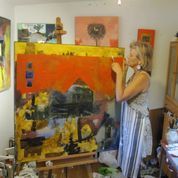
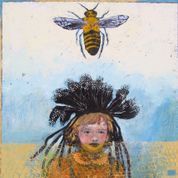
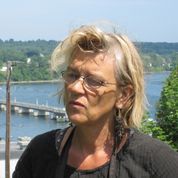
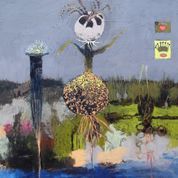
I was trolling through Facebook one day, when I saw a painting as writer Robyn Wright's profile picture. It was of a woman walking through the snow and the painting did something to me. It got into my bones and I became obsessed with finding out more about the artist and her work. I quickly friended Robyn and she asked the artist, Sheep Jones, if she'd consider being interviewed, and I'm thrilled Sheep said yes.
Sheep studied at the University of Maine at Portland/Gorham. She works in oils and wax, and her paintings have been shown in both solo and group shows along the East Coast and in Eastern Europe. Thank you so much, Sheep for letting me pester you with questions.
How did you first become an artist?
Growing up in a large Catholic family in Maine, we were exposed to music, but not art. There wasn’t much of an arts program in the Catholic girl’s school I attended from kindergarten through High School. When it came time to consider college, my parents and I compromised. They insisted on Art Education rather than Fine Art, as a more likely source of a job in the future.
I have to ask, where did you get the great name, Sheep?
I met Charlie (my husband) in High School. I had long hair and unruly bangs that were always in my face. When Charlie’s father noticed us hanging out together, he said, within earshot of a few of Charlie’s friends, “Who’s that Sheep Dog you’ve been hanging around with?” The name just stuck.
What's your daily working life like?
My job is painting. I work at the Torpedo Factory in Alexandria, VA. This building is open to the public every day. It has 3 floors, filled with artists who work and exhibit their art in separate studios. I am also represented in numerous galleries that feature me in shows. They also maintain bodies of my work.
Being visual and able to retain images for later use, I gather separate stills from movies, books, dreams, and stories. I also take photos of isolated shacks on my drives through the Maine landscape. I am always searching for the narrative in my paintings. When it starts to emerge I know I am almost finished.
Can you talk a bit about your world view and how it's incorporated in your paintings?
When I add a set of incongruous elements to a painting, it opens up a richer, more mysterious narrative than the straightforward storytelling you would find in a more traditional painting. Using images from life, my memory, and my imagination gives me a vast source of these elements, keeping the results slightly out of balance, which I find satisfying and exciting.
What's obsessing you now and why?
My latest figures are clad in versions of 17th century fashions. Perusing the internet, finding mny gems, has been my latest interest.
What question didn't I ask that I should have?
Has monocular vision affected my art? At the age of three, I lost the vision of my left eye. My sense of depth perception is compromised, and my paintings tend to have a flattened perspective.
Published on November 26, 2012 09:17
Meg Pokrass interview amazing quilter Joe Cunningham
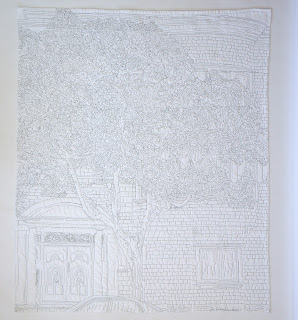
The divine Meg Pokrass interviews quilter Joe Cunningham. Thank you, thank you, Meg and Joe!
Joe Cunningham has been a professional quilt artist since 1979. He has written essays on the subject for museum catalogues, books and magazines. His book, “Men and the Art of Quiltmaking”was the first book on its subject. In 2004 he received a $30,000 Shulte Grant from the FortMason Foundation. In 2009 he received a grant to study with the Gees Bend quilters in Alabama. In 2010 he was artist in residence at the De Young Museum in San Francisco, which purchased one of his quilts for its permanent collection. Joe travels throughout the country to give lectures and workshops on quilt making. His eight books on quilt making include the first biography of a living quilter and a definitive book on marking quilts for quilting called “Quilting with Style,” published by AQS.
www.joethequilter.com
How did you become a quilter? What age? How did this art form find you, or you it?
I was born in 1952 in Flint, Michigan, and grew up in a small farm town nearby, where most of my friends were the children of factory workers. Growing up, all I ever cared about was music, books and art. I would skip school to go to the art institute. I would read books of art criticism by intellectuals who wrote well over my head, hoping that some day I would magically understand what the hell I was reading. Biographies of artists fascinated me.
None of my friends went to college. Instead, we all headed off into various self-made occupations. I had started playing guitar in nightclubs around town when I was 15 years old, so with that and working various day jobs, from hod carrier to dishwasher, cook to bus washer, I made my living.
I made friends with all the artists in my hometown, and sought any kind of connection to the art world I could manufacture. The thought never occurred to me that I could make art myself. I was not much talented at drawing. I was not much talented at writing or acting. I could play guitar pretty well, however, and I managed to parlay my modest abilities into a modest career as a musician from the time I was 15 to the time I discovered quilts when I was 27. I played any number of small bars, wedding receptions and after-hours joints, five or six nights a week. I even wrote a one-man musical about a hobo in the 1930's that got me a job teaching guitar at Colorado Northwestern Community College. There my teaching salary covered my tuition and books.
I thought I wanted to be a writer, so I studied nothing but English. I took 24 credit hours of mostly independent study in my second semester, since I had taken all the available creative writing and literature courses in the first semester. I liked it so much that I thought maybe I should become an English teacher. But then the next summer I ran into a box of quilts that changed my life forever.
The first time I saw these real quilts, in 1979, I found them dazzling, and tantalizing. Where art had always seemed distant and for someone else to create, the first thing that went through my mind was, "I could do this!" My mother made quilts, so I had seen them growing up; I had in fact slept under her tied comforters since I was little. Surely if my mother could make one of these I could.
First, however, the collector offered me the chance to write a catalogue about these quilts. I was interested in them, I wanted to be a writer and here was a writing project. In order to write about the quilts I had to learn quilt history. Fine. If I was not going to return to college, I thought, I should at least give myself a college education in quilts.
My mentors were Mary Schafer and Gwen Marston. Mary was born in Hungary in 1910, emigrated to the US in 1915 and lost her mother in the influenza pandemic of 1918. To make her a desirable marriage prospect, her dad sent Mary around to the neighborhood European ladies to learn the various needlework skills she would need. Eventually she married and had a son, then took up quilting in 1948. By the time I met her in 1979 Mary had won every possible blue ribbon in the state and had stopped entering competitions so her friends could have a chance.
Between Mary and Gwen, a younger expert quilter, I learned that to be the sort of quilter they respected I had to read all the literature so as to be familiar with the history of quilts and quilt fabric. Knowing the regional and ethnic styles would help me know how old a quilt was and where it may have been made. I had to become an engineer and designer of quilts and quilt patterns. I had to master all the techniques involved in making a quilt so as to be able to copy old quilts and absorb their lessons. All in all it was a sort of apprenticeship along classical lines.
It agreed with me. I loved the sewing and the study. Eventually, Gwen and I teamed up to make quilts together and ended up writing books and magazine articles about quilts, making videos and traveling all over the country to teach. We worked together for 12 years.
Altogether I think that my subconscious desire to be an artist, together with my idea that anyone could make a quilt, made becoming a quilter seem like a logical and desirable thing.
What is it like to be a male in a female-predominant art form?
Well, I understand that when a woman goes into a realm traditionally considered male, men will often do anything they can to keep the woman down, to shut her out, to marginalize her. In my case it has been the opposite of that. When I went into quilts I was a 26 year old tall white boy who felt comfortable around older women. Those older women responded by treating me like a most honored guest, and very quickly began treating me like an authority, an expert...instead of marginalized I got centralized. This continues more than 30 years later. But there are psychic aspects of quilt making I will never apprehend, whether it is from being a man or from being wired a certain way. For me, quilts have always represented an art project. For many quilters it is the community of women that is most important, and the actual quilts less so. The quilts are gifts to be given either to loved ones and friends or to charitable organizations to be dispersed. So I am a foreigner in this quilt world, psychically and physically. After a while, the subject of my gender becomes uninteresting in the quilt world. But it is a daily freakout to every single person who learns that I am a quilter. It is like my wife, to whom people used to exclaim, "But, you don't LOOK Jewish." But, I don't LOOK like a quilter. That just goes with the territory, and if I didn't enjoy the attention and the very freakiness of it, I would tell people I was a janitor, or a bookkeeper.
What is the hardest thing about being a male quilter? What is the best thing about being a male quilter?
This is actually two questions, now isn't it?
The hardest part is communicating the fact that I have dedicated my life to this thing, that I am struggling as hard as I can to do something original and serious. The very idea of a quilt seems to ward off serious thought and intention.
The best thing is that over the years I have come to know some of the most brilliant people in the quilt world, true scholars and wonderful human beings I almost certainly would never have had the chance to meet and share it all with if I were in another field.
What are some of the most exciting moments you have experienced in your career?
It is monumentally exciting to hold a copy of your first published book. Even though my first book was a simple Dover pattern book, I will never forget seeing my name on the cover the first time...the first time I sold a quilt to a museum for thousands of dollars...the first time I went to Gees Bend in Alabama and met--and quilted with--the women I had read so much about, whose quilts I had studied, was a great thrill. The best part of that trip was the very quilting itself, for this reason: my whole project from the beginning has been to apprehend how women of the 19th century thought and felt about quilt making, how they arrived at the the state of personal freedom that allowed them such unfettered creativity. In Gees Bend I was able to quilt with women who really had learned from their female relatives and forebears in a direct line back to the 19th century. Even though nothing of the mental state, the emotional or cultural condition could be articulated, I was able to just enjoy the immersion in the moment of working together and to enjoy the state--against all odds--of being, for a moment, a peer, just one of the people around the quilt frame. Of course that feeling vanished when the women started singing hymns in spontaneous harmony. Never have I felt more unnecessary or extraneous. The women had been singing together since the cradle. The beauty and, once again, the spontaneous creativity of it all, could only be insulted by my croaking along in a lower register. But that only emphasized all the more how lucky I was to be able to participate in the quilting as a peer, an equal.
Where to you ideas for design spring from. Do they find you, or do you find them?
My ideas come largely from my questions about quilts and art that I want to explore. Can I make a quilt that uses some of the Ab Ex ideas I like? Can I do the quilt I am most afraid of? What happens if I just cut this fabric in half and sew something else to it? What if I did this over and over? Could I make a modern version of an 18th century idea? etc.
Do you mentor? Have you had mentors?
I have had mentors. First there was Mary Schafer, who taught me her philosophy of quilting, as well as lots of technical information. Then there was Gwen Marston, Mary’s pupil and my partner, who initiated me into the world of quilts by showing me Mary’s and talking about quilts in a brilliant and fascinating way. Over the years, I have learned much from older women I met around the quilt frame. Birdie Rutherford taught me how to handle and thread needles better than I ever could before. Mary Hostetler taught me how to quilt in a circle. Lucy Mingo taught me how to think about the commercial and non commercial aspects of what I was doing. Julie Silber has been my mentor and friend since I met her in 1980 or so, constantly helping me to think about quilt history and the meaning of what we are doing in this crazy world. Randy French taught me how to see design in everyday objects, as well as the history of furniture, and indeed most everything I know about industrial design.
I have been a mentor to a couple of people, one who came to me and asked me to be her mentor and one young guy I met when I wrote a book about male quilters. Deborah now lives in Mt Shasta and makes great quilts. Luke spent some time here in San Francisco and used to come by my studio and ask questions all the time. Now he lives in Seattle and has had many shows of his work in galleries and museums, and he still calls and confers on quilt things.
William Wiley has been my friend and inspiration since I met him 10 or 12 years ago. Even though we have not spent a great deal of time together, every time we meet I am reminded of what I want to do, how I want to live, how I can be in the world.
Also, my late friend Pierre Cabrol, an architect from France who lived in LA for many years, and who did high-level work and who knew how to enjoy life. Pierre had the knack (like several of the European men I have known over the years) of making you feel like the most interesting person in the room...reminded me somewhat of Marcel Proust in the
Published on November 26, 2012 09:05

